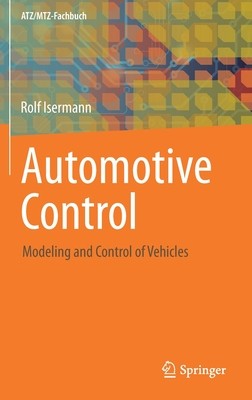
- We will send in 10–14 business days.
- Author: Rolf Isermann
- Publisher: Springer
- Year: 2018
- Pages: 450
- ISBN-10: 3642394396
- ISBN-13: 9783642394393
- Format: 15.6 x 23.4 x 3.7 cm, kieti viršeliai
- Language: English
- SAVE -10% with code: EXTRA
Reviews
Description
The introduction of mechatronic components for the powertrain, steering and braking systems opens the way to automatic driving functions. Together with internal and environmental sensors, various driver assistance systems are going to be developed for improving driving comfort and safety.
Automatic driving control functions suppose a well-designed vehicle behavior. In order to develop and implement the software-based control functions mathematical vehicle models for the stationary and dynamic behavior are required.
The book first introduces basic theoretically derived models for the tire traction and force transfer, the longitudinal, lateral, roll and pitch dynamic behavior and related components, like suspensions, steering systems and brakes.
These models have to be tailored to allow an identification of the many unknown parameters during driving, also in dependence of different road conditions, velocity and vehicle load. Based on these mathematical models drive dynamic control systems are developed for semi-active and active suspensions, hydraulic and electromechanical brakes including ABS, traction and steering control. Then driver assistance systems like adaptive cruise control (ACC), electronic stability control (ESC), electronic course control and anti-collision control systems are considered. The anti-collision systems are designed and tested for emergency braking, emergency steering and avoiding of overtaking accidents.
The book is dedicated to automotive engineers as well as to graduate students of mechanical, electrical and mechatronic engineering and computer science.
EXTRA 10 % discount with code: EXTRA
The promotion ends in 21d.22:55:30
The discount code is valid when purchasing from 10 €. Discounts do not stack.
- Author: Rolf Isermann
- Publisher: Springer
- Year: 2018
- Pages: 450
- ISBN-10: 3642394396
- ISBN-13: 9783642394393
- Format: 15.6 x 23.4 x 3.7 cm, kieti viršeliai
- Language: English English
The introduction of mechatronic components for the powertrain, steering and braking systems opens the way to automatic driving functions. Together with internal and environmental sensors, various driver assistance systems are going to be developed for improving driving comfort and safety.
Automatic driving control functions suppose a well-designed vehicle behavior. In order to develop and implement the software-based control functions mathematical vehicle models for the stationary and dynamic behavior are required.
The book first introduces basic theoretically derived models for the tire traction and force transfer, the longitudinal, lateral, roll and pitch dynamic behavior and related components, like suspensions, steering systems and brakes.
These models have to be tailored to allow an identification of the many unknown parameters during driving, also in dependence of different road conditions, velocity and vehicle load. Based on these mathematical models drive dynamic control systems are developed for semi-active and active suspensions, hydraulic and electromechanical brakes including ABS, traction and steering control. Then driver assistance systems like adaptive cruise control (ACC), electronic stability control (ESC), electronic course control and anti-collision control systems are considered. The anti-collision systems are designed and tested for emergency braking, emergency steering and avoiding of overtaking accidents.
The book is dedicated to automotive engineers as well as to graduate students of mechanical, electrical and mechatronic engineering and computer science.


Reviews